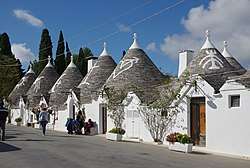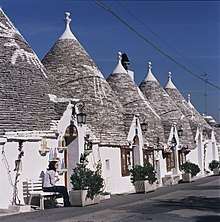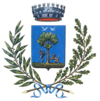Alberobello
| Alberobello | ||
|---|---|---|
| Comune | ||
| Comune di Alberobello | ||
 Three trulli | ||
| ||
 Alberobello Location of Alberobello in Italy | ||
| Coordinates: 40°47′N 17°14′E / 40.783°N 17.233°E | ||
| Country | Italy | |
| Region |
| |
| Metropolitan city | Bari (BA) | |
| Frazioni | Coreggia (Correggia nome originale) , l'unica frazione di Alberobello dal 1895. | |
| Government | ||
| • Mayor | Michele Maria Longo [1] | |
| Area | ||
| • Total | 40 km2 (20 sq mi) | |
| Elevation | 402.5 m (1,320.5 ft) | |
| Population (30-4-2017) | ||
| • Total | 10,718 | |
| • Density | 270/km2 (690/sq mi) | |
| Demonym(s) | Alberobellese(i) | |
| Time zone | UTC+1 (CET) | |
| • Summer (DST) | UTC+2 (CEST) | |
| Postal code | 70011 | |
| Dialing code | 080 | |
| Patron saint | Saints Cosmas and Damian | |
| Saint day | 25-26-27-28 September | |
| Website | Official website | |
| UNESCO World Heritage site | ||
| Official name | The Trulli of Alberobello | |
| Criteria | Cultural: iii, iv, v | |
| Reference | 787 | |
| Inscription | 1996 (20th Session) | |
| Area | 10.52 ha | |
Alberobello (Italian: [ˌalberoˈbɛllo]; literally "beautiful tree"; Barese: Aiarubbédde) is a small town and comune of the Metropolitan City of Bari, Apulia, southern Italy. It has 10 735 inhabitants and is famous for its unique trullo buildings. The trulli of Alberobello have been designated as a UNESCO World Heritage site since 1996.
History
A first anthropization of the area started only in the early sixteenth century on the impulse of the Count of Conversano Andrea Matteo III Acquaviva d'Aragona, son of the famous Count Giulio Antonio Acquaviva, who died in 1481 near Otranto, when 800 martyrs were killed in battle against the Ottomans . Count Andrea Matteo introduced from the fief of Noci about forty peasant families to reclaim and cultivate the land, with the obligation to give him the tenth of the crops.
His successor, the powerful Count Giangirolamo II, known as the Guercio delle Puglie because he had a blindfolded eye ( 1600 - 1665 ), in 1635 erected an inn with tavern and oratory, which started the urbanization of the forest with the construction of a conglomerate of small houses. The abundance of material, especially limestone and karst and calcareous sedimentary, and the permission of the count to build houses only with dry walls without the use of mortar, which became the characteristic trulli, contributed to the expansion of the urban agglomeration . This obligation to have houses built only with dry stones was an expedient of the count to avoid paying taxes to the Spanish viceroy of theKingdom of Naples according to the Pragmatica de Baronibus, law in force until 1700 according to which the construction of a new inhabited center involved first of all the royal assent and the consecutive payment of the tributes by the Baron to the Royal Court.
Alberobello was built on the streets of the ancient river Cana, where is now the largo Giuseppe Martelotta (also called largo delle fagade or largo della fiera).
Alberobello remained a fief of the Acquaviva of Aragon until May 27, 1797, when King Ferdinand IV of Bourbon, who was a guest in Taranto by the archbishop, welcomed the petition of a delegation consisting of three civilians and four priests from Alberobello (don Vito Onofrio Lippolis, Don Vito Nicola Tinelli and Don Francesco Sgobba) and issued a decree by which he elevated the small village to the royal city, freeing it from the feudal servitude of the counts. On 22 June 1797 the first mayor Francesco Giuseppe Lippolis was elected. In the same years the Casa D'Amore was also built by Francesco D'Amore, first cummersa with 2 floors. [ without source ] Alberobello is the only inhabited center in which there is an entire district of trulli. It is therefore considered cultural capital of the trulli of the Valle d'Itria.
The Trulli of Alberobello
.jpg)
The history of these very particular buildings is linked to the Prammatica De Baronibus, an edict of the 15th-century Kingdom of Naples that subjected every new urban settlement to a tribute. The Counts of Conversano D'Acquaviva D'Aragona from 1481, owners of the territory on which Alberobello stands today with the summer "domus" that was called Difesa De Le Noci on the border with the territory of the duchy of Martina Franca, then imposed on the peasants sent in these lands they built their dwellings dry, without using mortar, so that they could be configured as precarious buildings, easily demolished.
Therefore, having to use only stones, the peasants found in the round form with self-supporting domed roof, composed of overlapping stone circles, the simplest and most solid configuration. The domed roofs or half cone for straw called the false dome of the trulli are embellished with decorative pinnacles that represented as many say the pinnacle was the signature of the master trullaro who did it or that restored and represented the pose of the pinnacle an exciting moment, the whose form is inspired by profane symbolic, mystical and religious elements that appear above all in the Fascist period.
International relations

Alberobello is twinned with:





References
External links
| Wikivoyage has a travel guide for Alberobello. |
| Wikimedia Commons has media related to Alberobello. |



